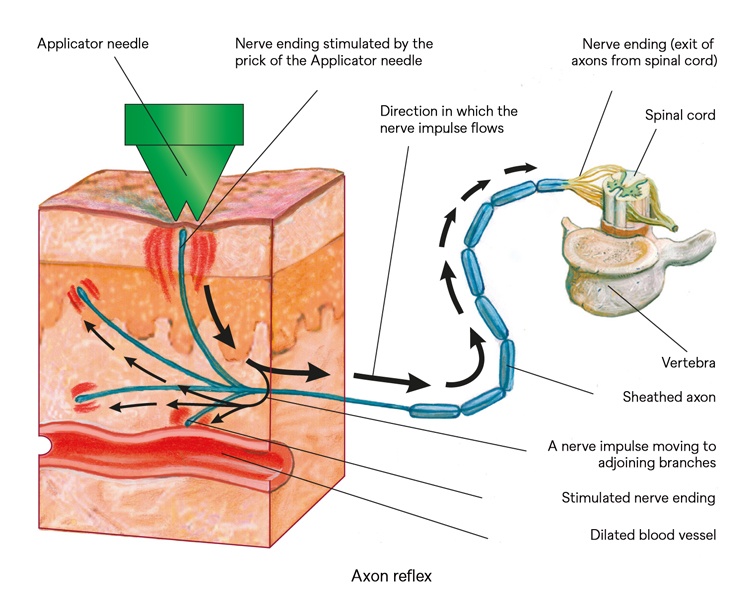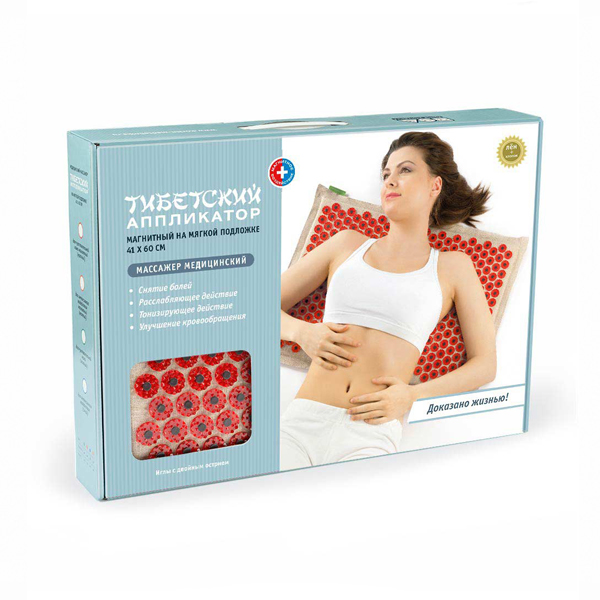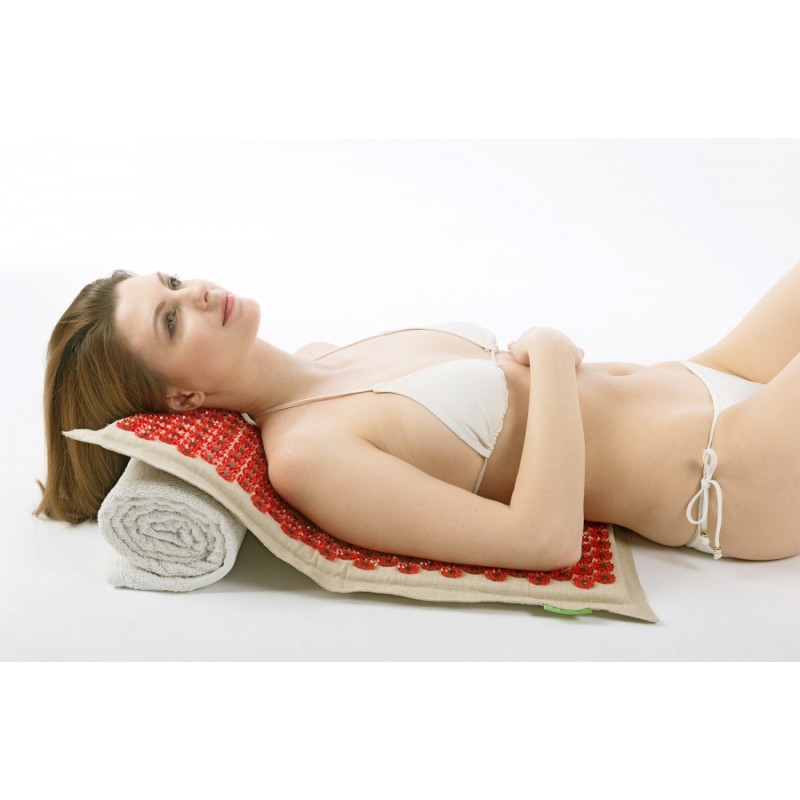Lindern Sie Ihre Schmerzen und steigern Sie gleichzeitig Ihre Selbstheilungskräfte mit der Akupressurmatte „Tibetische Anwendung Plus”.
Das Gehirn reagiert auf die Reflexwirkung, die durch die 13 032 Punkte auf der Akupressurmatte (362 Stimulatoren mit je 18 Doppelpunkten) erzeugt wird, indem es eine riesige Menge Endorphine (Hormone, die von der Hypophyse und dem Hypothalamus ausgeschüttet werden und eine starke schmerzstillende Wirkung haben) und Wohlfühlhormon produziert.
Muskel- und Gelenkschmerzen werden allmählich beseitigt, Ihre Muskeln entspannen sich, und Sie werden in ein tiefes Gefühl des geistigen und körperlichen Wohlbefindens eintauchen.
Die schmerzlindernde und entzündungshemmende Wirkung wird durch das natürliche Magnetfeld der Akupressurmatte „Tibetische Anwendung Plus”, die Magnete mit geringer Leistung für eine tiefere und stärkere therapeutische Wirkung enthält, verstärkt.
Dieses Produkt:
- Schützen vor elektromagnetischer Strahlung
- Erhöhen die Widerstandsfähigkeit und Anpassungsfähigkeit an negative Umwelteinflüsse
- Strukturieren Wasser oder andere Flüssigkeiten, einschließlich der Flüssigkeiten unseres Körpers
- Fördern die Revitalisierung und des Wohlbefindens
€79.00 €68.99
Out of stock
| Gesundheitsfokus | BLUTKREISLAUF, ENERGY & VITALITY, HEALTHY SLEEP, STRESS |
|---|---|
| Spiritueller Fokus | SERENITY & WELL-BEING |
DESCRIPTION
The “Tibetan Applicator” acupressure mat was developed in 1987 by the Russian professor Ivan Kuznetsov together with a team of scientists and doctors. After many years of clinical testing and because of its excellent therapeutic results, it was recognised as a medical device in Russia.
The mat is made from high quality linen (which is well-known for its antifungal and antibacterial properties) and cotton (adding 40% of cotton produces a nicer-looking and a softer-feeling material which does not crease, yet which retains the natural properties of linen).
THE ADVANTAGES OF NEEDLE MASSAGE
The “Tibetan Applicator” acupressure mat is designed to be used for needle massage. Needle massage has therapeutic effects on the different parts of the body, on the organs, as well as on all the body’s systems by means of reflexes.
The therapeutic effect of using multiple needles was mentioned for the first time in medical texts from ancient China and Tibet. It was Ivan Kuznetsov, who was very interested in this field of medicine and who created the first modern needle applicator, who introduced the term “needle massage” into modern medical practice in the 1980s.
In scientific research carried out by national and international experts, the practice of needle massage has five main effects:
- Vasodilatory effect
- Revulsive effect
- Reflex effect on the Zakharin-Head zones
- Reflex effect on the active areas (points) of the feet and the palms of the hands
- Setting in motion of the body’s universal protective reactions
1. THE VASODILATORY EFFECT
Starting at the spinal cord (the spinal column), long branches of nerve fibres called axons spread through the whole body. Axons can be likened to “electric wires” through which the nervous system receives or sends out signals. The axons start to branch out at a certain distance from the spinal cord, as if they were growing separate branches and they go through various organs including the skin. At the end of each of these “branches” is the nerve root.
In order to understand how the nervous system works, imagine that you are touching a hot kettle with your hand. At the same time, many nerve roots at the surface of the skin start sending signals by way of the axons to the spinal cord. The central nervous system (the spinal cord and the brain) processes the received information and gives the order to remove your hand.
HEALTH FOCUS
The vasodilatory effect of needle massage is linked to the “axon reflex”. This reflex, which was demonstrated in laboratory tests, and outlined by the English physiologist J.N. Langley, has been named after him. The axon reflex in needle massage works in the following way: by means of the nerve roots on the surface of the skin, the signal triggered by the prick of the needle is sent to the spinal cord via the axon. When it arrives at the point where the axon branches out, it goes to the axon’s adjoining branches and starts to move in the opposite direction until it ends up at their nerve endings (see diagram). As a result, biologically active substances (peptides) are released into these nerve endings, giving rise, amongst other things, to vasodilation. The dilation of blood vessels leads to an increase in the blood supply (plethora, hyperaemia), better tissue nutrition and an increase in metabolism (nutritional exchange) and restoration processes.

2. THE REVULSIVE EFFECT
In response to external or internal stimuli (e.g. contact with a hot object or back pain), a “centre of excitation” appears in our brain. In this way, our central nervous system (neuraxis) receives information about what is happening inside and outside the body. A surprising feature of these centres of excitation is that they can compete with one another, leading to one of them being “cut off”. Needle massage works in the same way, because by creating a centre of excitation, it “distracts” the brain from the site created by the sick organ. In order to explain how this needle massage works, we can take the example of back pain: a painful part of the body (e.g. the spinal column and the muscles of the back) creates a centre of pathological excitation in the central nervous system, with the result that the person feels pain.
- When the Applicator needles come into contact with the skin they send nerve impulses to the brain, where another centre of excitation is created, and the body is subjected to new and moderately painful feelings.
- The centre created by the Applicator gradually “distracts” our brain from the pathological centre and back pains disappear. Little by little, the pain resulting from the Applicators also decreases. This is due to the particular way that the impact of the needle is perceived by the nerve endings on the skin.
- Once the pain has gone, there is a feeling of warmth which is due to an excess of blood (vasodilatory action). In this way, needle massage, which was initially perceived as a painful method, actually has an indirect painkilling effect.
3. THE REFLEX EFFECT ON THE ZAKHARIN-HEAD ZONES
Physiologists have discovered the link between the internal organs and certain areas of the skin, and this link is based on their common origin. In fact, all biological tissue develops from a small number of “parent tissues”. During the intra uterine period, these tissues undergo complex differentiation and organs and organ systems are formed from them, yet the correlation at the level of the brain remains. Consequently, the signals (impulses) from the internal organs and the corresponding areas of the skin go to the same area of the brain, where a common centre of excitation is created. This correlation was studied and outlined in detail by the Russian doctor G. Zakharin and the English doctor H. Head, and the areas of the skin that they studied were named after them (Zakharin-Head zones).
How does the body react to illness in any of its organs? The centre of excitation caused by a painful process forces the brain to remodel the working of the body so that it can deal with the illness. “Internal medicine” (hormones and other biologically active substances) are produced via the nervous and endocrine systems, and favourable conditions for recovery are created (improvements in microcirculation, etc.). When the Applicator comes into contact with the area of skin corresponding to the sick organ, an additional signal is sent to the centre of excitation and the body starts working to combat the illness.
4. THE REFLEX EFFECT ON THE ACTIVE AREAS (POINTS) OF THE FEET AND THE PALMS OF THE HANDS
According to the principles of ancient Chinese medicine, our feet and the palms of our hands are special parts of the body where there is a concentration of a vast number of active areas (points) linked to the various internal organs. Present knowledge concerning anatomy and human physiology does not directly confirm these ancient ideas. However, modern medicine does not deny that palms, and, in particular, feet, are without doubt reflexogenic areas. Clinical studies show that needle massage of the feet has a very invigorating effect and stimulates the working of almost all the body systems, including the cardiovascular, digestive, nervous, hormonal, urinary and sexual systems, etc. Cases of stabilisation of blood pressure and the relief of cephalgia have been observed. According to scientists, needle massage has this effect because of the considerable nerve impulse that comes from the feet and the release of biologically active substances by the body. However, believers in Eastern medicine warn against over simplifying these processes.
Needle massage of the feet creates a feeling of vigour and improves the general state of health. In addition, such massages are pleasant and do not take very long.
5. SETTING IN MOTION OF THE BODY’S UNIVERSAL PROTECTIVE REACTIONS
The setting in motion of the body’s universal protective reactions, or, in scientific terms, “non-specific adaptations”, is the main way in which needle massage works, but it is also the most complex and the most interesting. In fact, it is this mechanism which has a “systemic” effect on the body; it increases its resistance to illness, speeds up recovery and improves the general state of health.
What are “universal defence reactions”? The human body is constantly affected by the outside environment. Air temperature and atmospheric pressure change, injuries and infections due to all sorts of pathogens occur, nervous strain develops or the need to take a lot of physical exercise emerges. For all these external stimuli, over millions of years of evolution the body has developed its own protective reactions. It has been convincingly demonstrated by 20th century medical research that in a great many cases the body reacts in the same way to different stimuli. For example, blood flow increases, anti-inflammatory activity is boosted, the hormonal and immune systems are activated, etc. This means that the body’s defence reactions are usually universal, or in scientific terms “non-specific”.
The body has defensive reactions (specific adaptation reactions) designed to solve any specific problem, and non-specific reactions with which the body fights against various negative environmental factors. An example of a specific reaction is the body’s reaction to an infection for which a vaccination has already been given. In this case, the body “knows” how to handle this concrete infectious agent, and when it is infected, the body quickly faces up to it. If immunity against an infectious agent has not been acquired, the body is forced to react in a universal manner (non-specific). One such reaction, for example, is the inflammatory process, when the body temperature increases and swelling is observed at the point of infection. In addition, inflammation occurs irrespective of the type of infection, i.e. it is a non-specific and universal reaction of the body. Most of the body’s reactions are generally non-specific.
- Selye, a Canadian academic, was the first to carry out a detailed study of the body’s non-specific (universal) protective reactions. He observed that living organisms had the surprising ability to respond in the same way to various external stimuli. His pupils, the Russian scientists L. Garkavi, M. Ukolova and E. Kvakina, identified several different types of stimulus by separating them depending on intensity of exposure. In accordance with this classification, needle massage is concerned with low, non-specific stimuli which activate certain non-specific protective (universal) reactions in the body. These reactions may include the increase of blood flow already mentioned, anti-inflammatory activity, the improvement in blood supply to internal organs, including the brain, and the activation of the hormonal and immune systems, etc.
In simple terms, the therapeutic effect of needle massage can be explained in the following way: The Applicators acting on the skin (even painfully) bring about a heavy flow of nerve impulses towards the central nervous system. Our body sees this as a signal that a type of threat has appeared. The body reacts to the appearance of this threat by using universal defence reactions.
The processes described above are useful not only for the treatment of illnesses, but also in preventing them. In the first case, by using needle massage, we imitate the appearance of another threat (in addition to the already present illness), and in this way, the body’s universal protective reactions are strengthened. As a result, the body’s fight against the real illness present is activated. We stimulate our body in the same way as a rider spurs their horse.
But needle massage is also a very effective way of getting yourself in shape, toughening up your body and preparing it in advance to come into contact with unfavourable external factors. In the same way as athletes recharge and exercise their muscles on a regular basis, by using needle massage we can regularly simulate a threat, thus regularly “triggering” our body’s universal defence reactions. In this way, the relevant systems of the body remain in good health, ready to face a real enemy such as an infection for example.
CONDITIONS OF USE AND STORAGE
If it is very dirty, clean the Applicator with detergent or soapy water using a soft brush, then rinse in clean water and dry.
The Applicator should be stored at a temperature of between 5 and 40°C. If they are knocked, the needles may be damaged.
IMPORTANT! The Tibetan Applicator is an object of personal hygiene. The skin may become very slightly damaged during needle massage, and use of the same Applicator by several different people is therefore strictly forbidden, unless it has been disinfected beforehand.
If you have given the Applicator to another person, carefully wipe the perforating parts of the Tibetan Applicator with alcohol or another means of disinfection before using it.
CONTRAINDICATIONS
The presence of protruding moles (naevi), papillomas, warts, verrucas and other growths in the affected area, dermatitis and oncological disease in any area.
IMPORTANT! In the event of strong independent reactions (heart palpitations, weakness, dizziness, etc.), the procedure must be used for a shorter time, less intensively, and if necessary, stopped completely.
IMPORTANT! Needle massage is not a panacea for all illnesses. It is most effective as one of the elements of a complex therapy prescribed by a doctor. Erroneous self-diagnosis and the lack of full and appropriate treatment at the right time may lead to serious negative consequences for your health.
GENERAL RECOMMENDATIONS
- It is best to perform needle massage 20 to 30 minutes before or 1 ½ to 2 hours after a meal.
- The room where the massage takes place should be well ventilated and have a comfortable temperature.
- Needle massage should be performed when the bladder and bowels are empty.
- The penetrating force should register on the pain threshold as a piercing effect accompanied by a feeling of warmth. The feeling of warmth indicates that the process is highly effective.
- At the end of the process, it is advisable to lie down for 5 to 10 minutes (unless the aim of the process is to increase muscle tone).
- The needles have a double point in compliance with the ancient Chinese method of “plum blossom” needle massage. The double point prevents the needles from penetrating the skin too deeply, making the treatment more comfortable and more effective.
- The therapeutic result is improved using special magnetic inserts with a magnetic field of between 3 and 8 mIT which provide the additional effect of a constant magnetic field.
- The Tibetan Applicator is registered as a medical device with the Russian Federation’s federal department in charge of the supervision of healthcare and social development.
*All information contained herein is for educational purposes only. No health claims are intended and statements made here have not been evaluated or approved by the European Medicines Agency (EMA) or the U.S. Food and Drug Administration (FDA). If you have a medical condition or if you seek medical advice, please consult your health care professional







